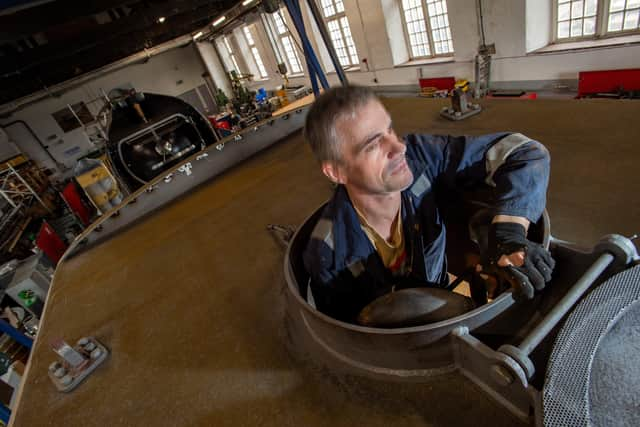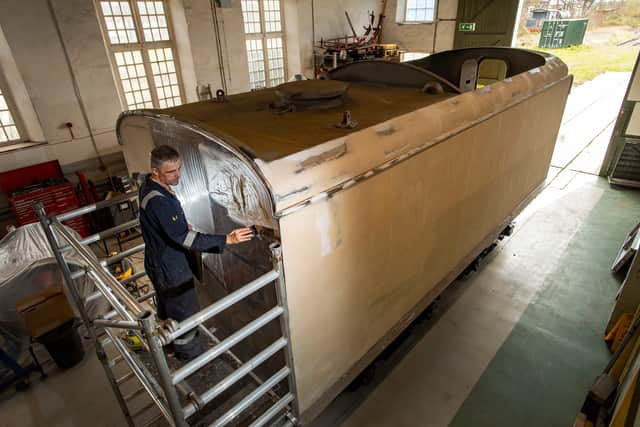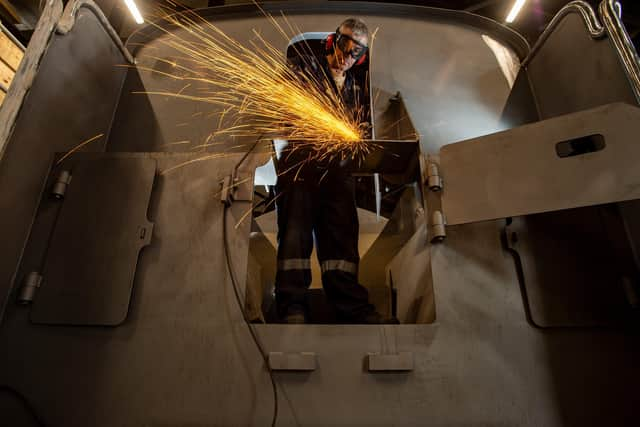‘Big moment’ for steam fans as Gresley’s Mikado takes shape in Darlington
The P2 class Mikado steam engines conceived in the 1930s by Sir Nigel Gresley, the engineer behind Flying Scotsman and the other record-breakers of the era, was supposed to haul 600-ton trains on the arduous route from Edinburgh to Aberdeen. But Gresley’s design was never fully developed.
However, a modern-day attempt to finish the job he began has got up a new head of steam, its organisers have said.
Advertisement
Hide AdAdvertisement
Hide AdThe tender tank that now stands inside a hangar-like building beside the railway line in Darlington, may look like an empty shipping container but it represents the most important milestone yet in the race to build an all-new Mikado for the public and preserved rail lines of the 21st century.


The finished product will be Britain’s most powerful steam locomotive.
The tank arrived at the Darlington works, more than six years after the project was first mooted and having undergone hydraulic testing and grit blasting, on the back of a low-loader. Awaiting it was a set of railway bogies acquired and restored by the A1 Steam Locomotive Trust, which previously built the Peppercorn class A1 class locomotive Tornado, the first to be built in Britain since the steam age ended.
“It was massively exciting to see the tender tank,” said Mark Allatt, the project manager, who described the distinctive look of the engine as being “drop dead gorgeous”.
Advertisement
Hide AdAdvertisement
Hide Ad“It’s not a particularly complex part of the overall build but it was still a big moment – a very visual statement of the progress the project is making. It’s one of the big things that people can see as a material change as the locomotive becomes structurally complete.”


The 2,500 horsepower locomotive, which will be named 2007 Prince of Wales, continuing the sequence begun by Gresley, is costing £5m to build and remains on schedule to be operational by 2022.
“It’s the first time a locomotive looking like this has been around for 80 years. You can’t get more exciting than that,” Mr Allatt said.
“A lot of the work we’re doing is finishing the design work Sir Nigel started, and applying modern techniques and materials.
Advertisement
Hide AdAdvertisement
Hide Ad“The thing that the originals never had on them at all, which is incredibly complex these days, is the electrical system. But in order for a steam locomotive to work on the main line today, it has to have all the monitoring and safety systems a modern railway vehicle would have.”


The builders did not have the benefit of rotting originals as templates – those had been scrapped 60 years ago, when steam gave way to diesel. Instead, they worked from the original drawings, which had been preserved at the National Railway Museum in York.
“It has sometimes been a struggle to get across the fact that it’s not something we’ve rescued from a scrap yard or restored from bits we’ve found. This is totally new,” Mr Allatt said.
Six P2 class locomotives were originally built, most at Doncaster, and given Scottish names like Thane of Fife and Wolf of Badenoch.
Advertisement
Hide AdAdvertisement
Hide AdThe newly-built, 6,250 gallon tender tank, which gives its engine a range of 110 miles, was funded from a £450,000 appeal, launched a year ago, with a target of raising £1,500 each, in instalments, from 250 supporters.
A series of other “clubs” are being run to complete the financing for the other components.
“Project manager Mark Allatt said: “There is a lot of work still to do, but we are making progress on all fronts.”
Editor’s note: first and foremost - and rarely have I written down these words with more sincerity - I hope this finds you well.
Advertisement
Hide AdAdvertisement
Hide AdAlmost certainly you are here because you value the quality and the integrity of the journalism produced by The Yorkshire Post’s journalists - almost all of which live alongside you in Yorkshire, spending the wages they earn with Yorkshire businesses - who last year took this title to the industry watchdog’s Most Trusted Newspaper in Britain accolade.
And that is why I must make an urgent request of you: as advertising revenue declines, your support becomes evermore crucial to the maintenance of the journalistic standards expected of The Yorkshire Post. If you can, safely, please buy a paper or take up a subscription. We want to continue to make you proud of Yorkshire’s National Newspaper but we are going to need your help.
Postal subscription copies can be ordered by calling 0330 4030066 or by emailing [email protected]. Vouchers, to be exchanged at retail sales outlets - our newsagents need you, too - can be subscribed to by contacting subscriptions on 0330 1235950 or by visiting www.localsubsplus.co.uk where you should select The Yorkshire Post from the list of titles available.
If you want to help right now, download our tablet app from the App / Play Stores. Every contribution you make helps to provide this county with the best regional journalism in the country.
Sincerely. Thank you.
James Mitchinson, Editor
Comment Guidelines
National World encourages reader discussion on our stories. User feedback, insights and back-and-forth exchanges add a rich layer of context to reporting. Please review our Community Guidelines before commenting.